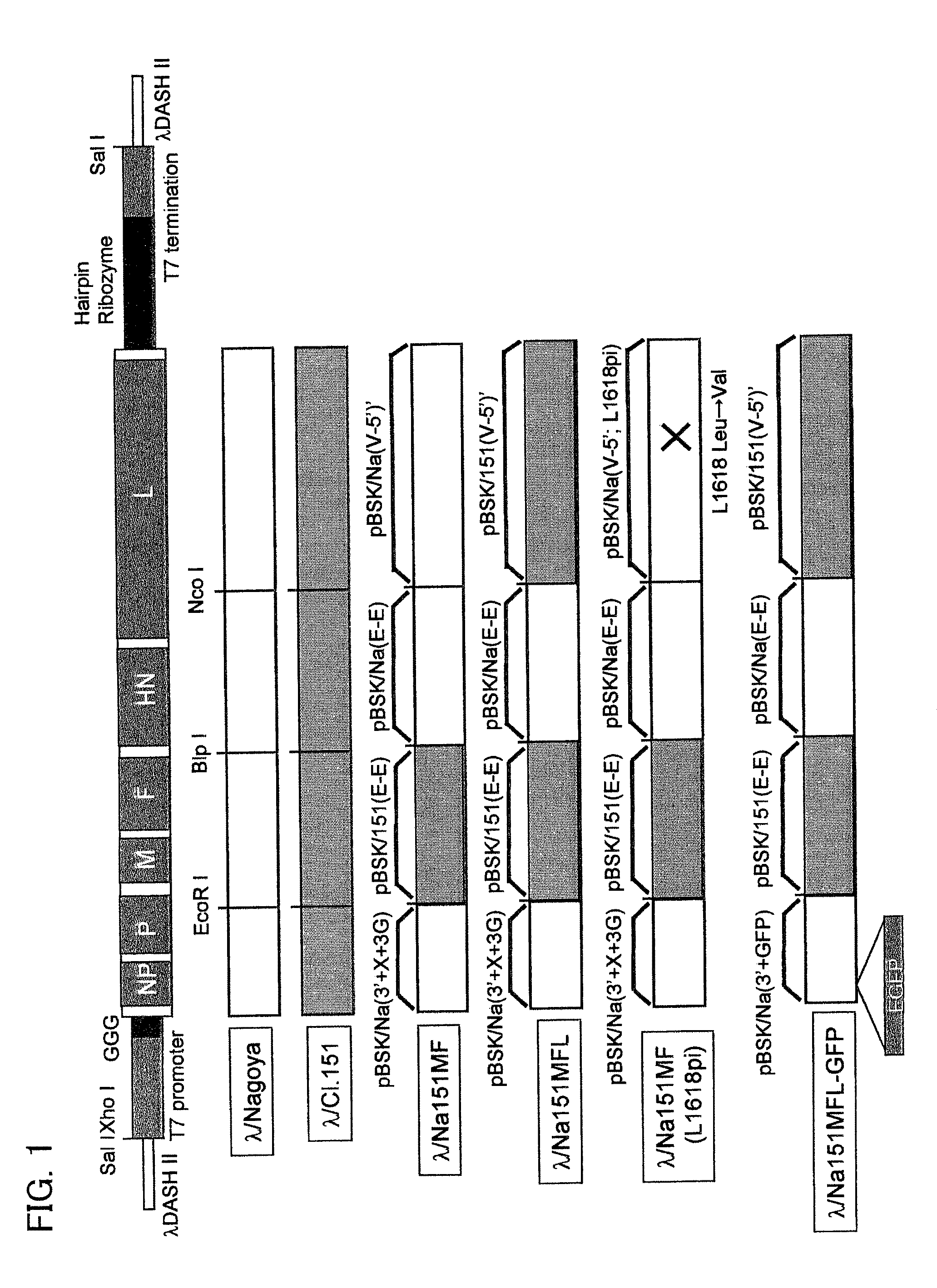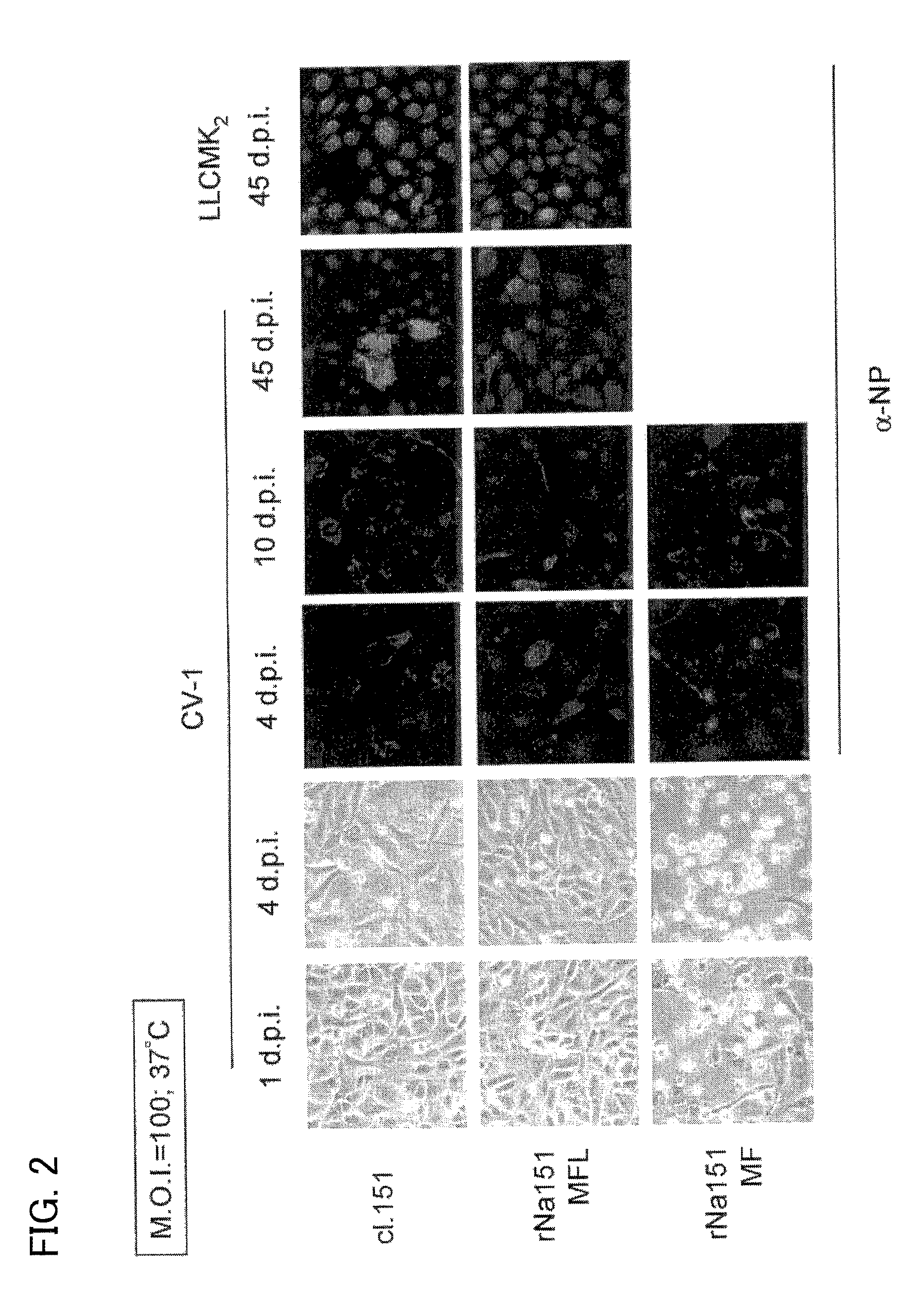Persistently infective Sendai virus vector
a virus and persistent infection technology, applied in the field of virus vectors, can solve the problems of low species specificity, high gene expression activity of virus, and inability to understand the mechanism of persistent infection, so as to achieve the effect of reducing cytotoxicity and maintaining expression
- Summary
- Abstract
- Description
- Claims
- Application Information
AI Technical Summary
Benefits of technology
Problems solved by technology
Method used
Image
Examples
example 1
Producing Recombinant Sendai Virus (rNa151MFL and rNa151MF)
(1) Producing Recombinant Sendai Virus Producing Vector
[0204]A cDNA obtained by cloning the full length cDNA of Sendai virus strain C1.151 or Nagoya strain was separated into three fragments. A T7 promoter sequence and a guanidine residue including three bases were inserted in this order immediately upstream of the sequence containing a Sendai virus cDNA in the sequence of a fragment containing SeV: 1-2875 (pBSK / Na(3′-E) [derived from Nagoya strain], pBSK / 151(3′-E) [derived from strain C1.151]) (pBSK / Na(3′+X+3G), pBSK / 151(3′+X+3G)). A SeV: 15351-15384 part was cut out from a fragment containing SeV: 10479-15384 (pBSK / Na(E-5′), pBSK / 151(E-5′)). That part, immediately downstream of which the hairpin ribozyme sequence of a tobacco ring spot virus and a T7 RNA polymerase termination sequence were inserted in this order, was recloned into pET30a(+) (Novagen) (pET / Na(5′+HrD), pET / 151(5′+HrD)). Furthermore, this fragment of SeV: 15...
example 2
Confirming Persistent Infectiveness of Recombinant Sendai Virus in Cells
[0208]CV-1 cells or LLCMK2 cells were plated on a 12-well plate and cultured for 24 hours. After the culturing, the virus suspensions were diluted with a medium to M.O.I.=100 and distributed in the wells to cause infection at 37° C. The cells were washed 24 hours later. Then, a medium containing no virus was added. The infected cells were observed to see whether they were dead or alive while culturing them at 37° C. In addition, infection of the cells was confirmed by a fluorescent antibody test using an antibody against Sendai virus.
[0209]As shown in FIG. 2, cytotoxicity was observed in the CV-1 cells infected with rNa151MF about as late as 4 days after the infection. No cytotoxicity could be observed in CV-1 cells infected with rNa151MFL, similarly to CV-1 cells infected with strain C1.151. Later, 10 days after the infection, marked omission of the virus from the infected cells was confirmed in the CV-1 cells ...
example 3
Producing Exogenous-Gene-Inserted rNa151MFL Strain (1); Integrating Exogenous Gene Insertion Site
[0211]A Not I recognition sequence was inserted to pBSK / Na(3′+X+3G) after SeV: 119 by Quikchange Site-directed Mutagenesis II (STRATAGENE) by using 5′-GCCAAAGTTCACGCGGCCGCAGATCTTCACGATGGCCGGGTT GT-3′ (SEQ ID NO 11 (sense strand) in the Sequence Listing) and 5′-ACAACCCGGCCATCGTGAAGATCTGCGGCCGCGTGAACTTTG GC-3′ (SEQ ID NO 12 (antisense strand) in the Sequence Listing) as an exogenous-gene-insertion-site producing primer (pBSK / Na(3′+Not)).
(2) Introducing Exogenous Gene (EGFP Gene)
[0212]An EGFP gene was amplified from pEGFP-C1 (Clontech) by using two primers, 5′-ACTTGCGGCCGCTCGCCACCATGGTGAGCAAGGGCGAGGA-3′ (SEQ ID NO 13 (N terminus end) in the Sequence Listing) and 5′-ACTTGCGGCCGCGATGAACTTTCACCCTAAGTTTTTCTTAGAC GGCCGCTTTACTTGTACAGCTCGTCCA-3′ (SEQ ID NO 14 (C terminus end) in the Sequence Listing) as EGFP gene insertion primers. The termini of the obtained double-stranded DNA were cleaved with ...
PUM
| Property | Measurement | Unit |
|---|---|---|
| temperature | aaaaa | aaaaa |
| temperature | aaaaa | aaaaa |
| temperature- | aaaaa | aaaaa |
Abstract
Description
Claims
Application Information
 Login to View More
Login to View More - R&D
- Intellectual Property
- Life Sciences
- Materials
- Tech Scout
- Unparalleled Data Quality
- Higher Quality Content
- 60% Fewer Hallucinations
Browse by: Latest US Patents, China's latest patents, Technical Efficacy Thesaurus, Application Domain, Technology Topic, Popular Technical Reports.
© 2025 PatSnap. All rights reserved.Legal|Privacy policy|Modern Slavery Act Transparency Statement|Sitemap|About US| Contact US: help@patsnap.com



